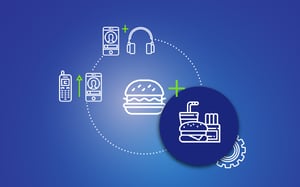If you had to explain why you’re in the retail business, you’d likely come up with at least two reasons: to delight customers and make money. But how? You have many options available to you. Implementing data-driven planograms will help. Applying the correct merchandising technique and principles will work too. Then there is the sales approach known as upselling.
What is upselling [and why is it essential]?
According to Shopify, upselling is a sales technique used to get your customers to spend more than they had intended. That’s achieved by convincing any shopper who enters your store in search of one product to upgrade to another, more expensive item. Now, from a technical point, that’s correct. However, it doesn’t tell the full story.
While upselling is all about influencing a shopper to buy a more expensive product, for it to work effectively, your salespeople need first to consider who the shopper is and what it is they want. We’ll explain that in more detail later on in this piece when we talk about the questions you need to ask yourself.
For now, it’s worth pointing out that the more expensive item that you want the customer to buy needs to hold enough value for them to justify purchasing it.
Let’s say, for example, that you have a Consumer Electronics and Appliance store and a customer comes in wanting to buy a fridge. What you shouldn’t do is try to sell a related or complementary product while they’re browsing your range. That’s cross-selling, which, while worthwhile, can also irritate a customer when done inappropriately.
After all, they may come into your store for a specific product and nothing else and here’s your salesperson trying to sell a different product to them in the hope that they’ll add it to their basket.
Continuing with the above example, if you’re looking to upsell them, you should instead look at selling a fridge that comes with a 5-year warranty as opposed to one without. While it’s pricier than the one that the customer had initially intended to buy, there is enough justification for them to buy it.
If you've done it right, you’ve closed a deal that’ll put more money in your pocket.
Of course, that’s not the only reason for employing such a tactic. Another reason is that it can also lead to deeper, more meaningful relationships between you and your customers. That’s because you’re listening to them first (finding out what they need) and selling second.
Questions to ask yourself before you begin upselling in-store
As we’ve noted already, employing a sales technique such as upselling in your store can lead to increased sales and happier customers. That said, you can’t begin upselling - and applying it successfully - until you’ve asked yourself a series of questions.
There are usually two questions that you should ask yourself.
1. Does the product solve the customer’s problem?
Before you can begin thinking about upselling a client on a pricier product, you need to assess the situation. More importantly, you need to consider how your product can solve their problem.
For example, you’re a Consumer Electronics and IT retailer selling computers and software. When a customer walks in, intending to purchase a new laptop, you know that they’ll need additional software. You’d thus look at selling them a computer that includes such software but at a slightly higher price. They’ll consider purchasing because it’s worth it.
If all the laptops you sell come with software at no additional cost, you might then want to sell one that includes a warranty. Since laptops can be pricey - you don’t usually buy them often - you’re giving your customers peace of mind.
The rule of thumb when asking (and answering) the question of whether or not the product solves the customer’s problem is this: consider the product you sell and uncover a challenge that it introduces. Once you know the challenge, upsell your customers on the solution to help them overcome it.
2. Is the product relevant to the customer’s original purchase?
It doesn’t matter what you want to sell to a customer; if you're going to see any form of success, you need to ensure that the product you’re upselling is relevant to their original purchase.
It forms the base of the second question, and it can work as a reality check. If you’re unsure about whether or not you should upsell a client on a particular product, ask yourself this: is the product similar enough to their original choice?
In short, would it make sense for the customer to make the additional purchase when they’ve entered your store for a different product?
Of course, there is also the converse to consider: why would you want to try to sell a product that’s unrelated to the one that your customer wants to buy? Yes, there is such a technique as cross-selling, and it can work. However, in this case, you’re likely to confuse the shopper and make them question your motive. They’ll wonder if you’re listening to them or, are only interested in making a sale, no matter what.
If you rather focus on upselling relevant products, you’ll have a better success rate. More importantly, you’ll offer value to shoppers who will return to your store, knowing that you have their best interests at heart.
Upselling techniques to try in your store today
There are a few upselling techniques that you can employ within your store.
By the way, regardless of which of the below techniques you adopt in-store - use them all if you want - you must always keep the above two questions in mind.
1. Bundle products to offer value
The first upselling technique worth using in-store is to bundle products together.
The reason for that should be simple. By bundling products, you’re creating a perception of value, which will always lead to more sales. This is especially true if the products are pricey on their own and your customer is looking for a bargain.
Mind you, you do need to ensure that the bundled products are similar in purpose and make sense to the customer.
Let’s say you sell large appliances such as branded gas stoves. Whenever any shopper buys this product, you could include a gas bottle for the stove as part of the deal. While done at a discounted rate, the volume of sales and unit movement could make up for this.
The discounted rate along with the fact that these are bundled also make it easier for your customers to pick them up. Just keep in mind where you merchandise these products in-store. You may have a great deal that you know your customers want, but it won’t mean a thing if they can’t see it.
That said, you also need to be careful about your pricing. There have been instances where bundled prices were the same price as the original items on their own. A bundled deal might pull in an impulse shopper, however, beware of the customer who checks prices and notices there is no difference or value in going for the special.
It’s also worth pointing out that there is no law around bundled offers. It doesn’t have to be of low value to be attractive. You could group expensive items, and more effectively so to represent value for money.
2. Incentivise customers to buy more
While bundling products is an effective way to encourage customers to increase their purchase, another powerful approach is to incentivize them.
In short, give your customers enough motivation to want to spend more in your store.
You can see such a technique used effectively in supermarkets like Checkers or Pick n Pay who have gamified their loyalty programme. By spending a certain amount per shop, customers receive a reward. And it’s worked well; you only need to consider that for Pick n Pay alone, doing this increased its turnover by 8.5% in six months.
It works just as well for any other retailer, regardless of the products on sale. For example, you could be a clothing retailer who also sells beauty products. In this instance, you could create a deal where, if a customer buys a particular perfume, they could get a bottle of hand cream included, either for free or at a reduced price.
Of course, you do need to ensure that the deal contains something of value to the majority of your customers. For example, if you run an in-store butchery, it would be better to create a deal around a product such as chicken, which has high volume movement and is in demand rather than around steak, which might not sell as much, even when on special.
Running a loyalty programme can also help you to entice customers to buy more when in-store. The most obvious tactic, in this case, is to offer reward points for purchasing any product of above a specific price or promise a discount on upcoming purchases based on their total spend in-store.
A ‘Buy Two and Get Double Points’ or a ‘Buy Three Get One Free’ are just two simple examples of how you can motivate additional spending.
3. Include a guarantee to reduce buyer hesitation
Whenever you come across a great deal in a store or elsewhere, there is always a thought about whether it’s too good to be true. Is there a catch that they’re unaware of and will only find out about once they’ve purchased?
When they do find out that there is a snag, your customers feel angry and cheated. It also goes a long way to help decide if they’ll return to that store or not. That’s what can happen if you’re attempting to reduce buyer hesitation but from the wrong angle. It can also go right.
Let’s say, for example, that you’re an accredited agent for a TV cable company. You could offer free installation services so that your customers don’t have to install it themselves. If you’re a retailer who sells laptops instead, you could suggest setting it up in-store before your customer takes it home. Alternatively, if you stock cameras, you could offer free training for customers so they can feel confident when they use them for the first time.
As you’ll note, all the above pertain to products that require some form of involvement from your customer. By adding support for such a product, you’re able to reduce buyer hesitation.
On the other hand, you could also offer extended warranties as a way to reduce hesitation. That’s if the product is expensive and needs to last. The fridge or gas top stove we mentioned earlier are two prime examples.
Conclusion
Since many of your customers want peace of mind - especially so if the product they’re buying is expensive - you need to show them that you’re on their side. In brief, you’re thinking about their wants and needs first and your pockets second.



